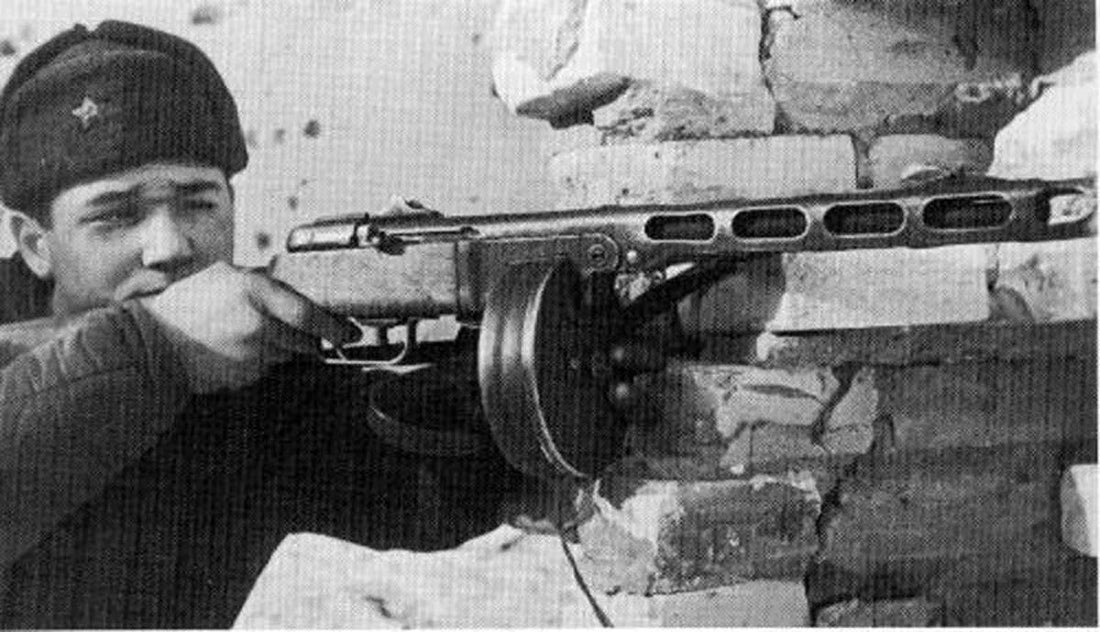
The PPSh-41: A Soviet Icon – History, Impact, and the Denix Replica
Share
I. Introduction
The PPSh-41 submachine gun stands as a testament to Soviet ingenuity during World War II, combining simplicity, reliability, and firepower. Designed by Georgy Shpagin in 1941, the PPSh-41 was developed to address the Red Army's need for a cost-effective and efficient close-quarters weapon. Its design featured stamped metal parts, a high rate of fire of approximately 900 rounds per minute, and compatibility with both 71-round drum magazines and 35-round box magazines. The PPSh-41 saw extensive use on the Eastern Front, becoming iconic among Soviet troops and even being adopted by German forces under the designation MP41(r) when captured. Its legacy continued post-war, with variants appearing in conflicts such as the Korean War and being supplied to various allied nations.
For enthusiasts and collectors, the Denix replica of the PPSh-41 offers a non-firing, museum-quality reproduction. Crafted from metal and wood, it features a removable magazine, working bolt and trigger, and a realistic weight and feel. While it does not fire live ammunition, the Denix replica serves as an excellent alternative for display, reenactments, or educational purposes, capturing the essence of the original without the associated risks.
II. Origins and Development

Before the PPSh-41, the Soviet Union relied on the PPD-40 submachine gun. Although effective, the PPD-40 proved costly and time-consuming to produce. It was manufactured using complex machining processes and was not suited to the high-volume production needed during wartime. The outbreak of World War II created an urgent demand for a new submachine gun that could be mass-produced quickly and cheaply while maintaining combat effectiveness.
The man behind the PPSh-41 was Georgy Shpagin, an experienced weapons designer who had worked on a variety of Soviet firearms projects. Shpagin’s vision was to create a weapon that could be made using simple stamped metal components rather than complex machined parts. This approach significantly reduced production time and costs, allowing the Soviet Union to arm its rapidly expanding Red Army efficiently.
The development of the PPSh-41 was also heavily influenced by lessons learned during the Winter War (1939–1940) between the Soviet Union and Finland. Finnish forces made extensive use of the Suomi KP/-31 submachine gun, which proved devastating in close-quarters combat. Soviet military strategists recognized the need for a similar weapon capable of delivering high volumes of fire in trench and urban warfare settings. These insights directly informed the design priorities of the PPSh-41: high rate of fire, ease of use, and mass producibility.
III. Design and Technical Specifications

The PPSh-41 was engineered for mass production and battlefield durability. Its construction emphasized simplicity: stamped sheet metal parts were riveted and welded together, drastically reducing the need for skilled labor and specialized machinery. The gun featured a wooden stock, which provided a solid shoulder mount while also simplifying logistics since wood was readily available.
Chambered in 7.62×25mm Tokarev, a powerful pistol cartridge, the PPSh-41 offered excellent penetration and a flat trajectory. This made it more effective at medium range than many other submachine guns of the era. Its blowback, open-bolt operation was simple and robust, further reducing the likelihood of malfunctions in harsh combat conditions.
One of the defining features of the PPSh-41 was its rate of fire—around 900 rounds per minute. This gave soldiers immense firepower in close engagements. The gun could be fitted with either a 71-round drum magazine or a 35-round box magazine. While the drum offered a much higher ammunition capacity, it was heavier and more prone to mechanical issues. As a result, some units favored the box magazine for its better reliability and easier handling.
IV. Production and Distribution

The Soviet Union began mass production of the PPSh-41 in 1941, as soon as it was officially adopted. One of the greatest strengths of the design was its adaptability to wartime production environments. Factories not originally intended for arms manufacturing, such as automotive and mechanical workshops, were repurposed to produce the weapon. This decentralized approach allowed the USSR to manufacture more than 6 million PPSh-41 units by the end of World War II.
The simplicity of the PPSh-41's design played a crucial role in this production miracle. Compared to the PPD-40, the PPSh-41 required far fewer machining hours and could be assembled with relatively unskilled labor. Its stamped parts were easy to produce in bulk, and components were standardized to allow for easy assembly and replacement.
The Soviet strategy also included equipping whole platoons with submachine guns like the PPSh-41, giving infantry units formidable close-range firepower. This tactic differed significantly from Western approaches that relied more heavily on bolt-action rifles. The result was a Red Army force that could unleash tremendous volumes of automatic fire during assaults, especially in urban and trench environments.
V. Combat Performance and Tactical Use

In combat, the PPSh-41 quickly proved its worth. On the Eastern Front, where brutal house-to-house fighting was common, its high rate of fire and large magazine capacity gave Soviet soldiers a major advantage. Troops could clear rooms or trenches quickly, with the ability to fire continuously without reloading for long periods when using the 71-round drum.
During the Korean War, North Korean and Chinese forces relied heavily on Soviet-supplied PPSh-41s. U.S. and UN troops encountered these weapons regularly, and many acknowledged their effectiveness. The high rate of fire could overwhelm defenses and cause significant casualties, especially in nighttime or close-range engagements. American troops often commented on the gun's 'burp' sound, giving it the nickname 'burp gun.'
The PPSh-41 was also used extensively during the Vietnam War, where Viet Cong guerrillas employed the weapon against U.S. and South Vietnamese forces. Its reliability and ease of use made it ideal for irregular warfare. Even decades after World War II, the PPSh-41 continued to serve in various conflicts around the globe, a testament to its rugged and effective design.
VI. Global Influence and Legacy
Following World War II, the PPSh-41 found a second life as a standard weapon among many of the Soviet Union’s allies. Because of its ease of manufacture and effectiveness in combat, it was exported widely across Eastern Europe, Asia, and the Middle East. Countries such as China produced their own licensed and unlicensed versions, like the Type 50. North Korea followed with the Type 49, virtually identical in performance to the original Soviet design.
These variants were used extensively in numerous post-war conflicts, including colonial uprisings, civil wars, and revolutions. The weapon’s affordability and simplicity made it a favorite among guerrilla forces and insurgent movements. Its iconic silhouette and devastating firepower earned it a prominent place in 20th-century warfare and pop culture.
Even today, PPSh-41s can occasionally be found in use by irregular forces in regions with long-standing conflict. Museums and private collectors prize the weapon for its historical significance and visual impact. Its legacy lives on not only in historical archives but also in films, video games, and reenactments where it symbolizes the might of the Red Army.
VII. Variants and Modifications

The most well-known wartime modification of the PPSh-41 came from the German Wehrmacht, who captured thousands of these weapons on the Eastern Front. Rather than discard them, the Germans converted them to fire 9mm Parabellum, the standard cartridge of the MP40 and other German submachine guns. These captured and modified guns were designated MP41(r) and issued to second-line and occupation forces.
Post-war, the Soviet Union developed the PPS-43 submachine gun as a more compact and efficient follow-up to the PPSh-41. While it lacked the same magazine capacity and iconic status, it became the standard-issue Soviet submachine gun until it was gradually replaced by the AK-47 assault rifle in the 1950s. Despite this, the PPSh-41 continued to serve in various countries’ arsenals well into the 1970s and beyond.
In terms of design evolution, the simplicity and effectiveness of the PPSh-41 influenced future generations of submachine guns and automatic carbines. Its combination of rapid-fire capability, robust build, and ease of manufacture became a blueprint for low-cost small arms in the developing world.
VIII. The Denix PPSh-41 Replica

For collectors, reenactors, and history enthusiasts, owning a functional PPSh-41 is often not feasible due to strict firearm regulations, high cost, and rarity. That’s where the Denix non-firing replica of the PPSh-41 provides an excellent alternative. Made by the Spanish company Denix, known for its museum-quality reproductions, this replica offers the look and feel of the original weapon without any of the legal or safety complications.
Constructed from a combination of metal and wood, the Denix replica mimics the authentic dimensions, materials, and design of the real PPSh-41. It includes a removable magazine, a working bolt, and an operational trigger that provides a tactile experience reminiscent of the original. While it does not fire, these mechanical details enhance its realism for display or educational purposes.
Visually, the replica is nearly indistinguishable from the real thing, making it a favorite among reenactors and filmmakers seeking historical accuracy. The weight is also comparable, giving it a solid and authentic presence when held or mounted on a wall. The wooden stock, metallic housing, and drum magazine are all carefully crafted to replicate the wartime model used by Soviet troops.

IX. Comparative Analysis: Original vs. Denix Replica
From a distance, the Denix replica of the PPSh-41 is visually indistinguishable from the real firearm. It captures the iconic lines, shape, and finish of the Soviet submachine gun, down to the curved trigger guard and large drum magazine. This makes it a fantastic piece for collectors who want to own a historically significant weapon without the burden of licensing, registration, or legal constraints.
While the original PPSh-41 is capable of firing the powerful 7.62×25mm Tokarev round at rates up to 900 rounds per minute, the Denix replica contains no internal components capable of chambering or discharging ammunition. This makes it legal to own in many countries and U.S. states where real submachine guns are heavily restricted or banned.
The replica’s main value lies in its educational and aesthetic appeal. Military museums, schools, and reenactment groups can use it to demonstrate the design and mechanics of World War II-era weapons without safety risks. Collectors appreciate the authenticity of the build, while filmmakers often rely on Denix models for period-accurate props that won’t raise legal or logistical issues during production.
X. Conclusion
The PPSh-41 submachine gun is one of the most iconic weapons of the 20th century, known for its remarkable contribution to Soviet military success in World War II and beyond. Its high rate of fire, durable construction, and revolutionary manufacturing process made it an indispensable tool for Soviet infantry and an influential blueprint for future firearms. Even decades after its inception, the PPSh-41 remains a symbol of innovation, adaptability, and raw firepower.
For those who want to own a piece of this storied history, the Denix non-firing replica offers a compelling option. With faithful craftsmanship and historically accurate design, it serves as both a tribute to the original weapon and a practical alternative for collectors, educators, and filmmakers. While it lacks the capability to fire, it retains all the visual and tactile qualities that made the PPSh-41 so memorable.
Whether displayed on a wall, used in a reenactment, or presented in a classroom, the Denix PPSh-41 stands as a respectful homage to one of the most important firearms in military history.
Be sure to pick up your non-firing replica of this abundantly rich historical piece here!

